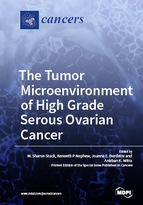The Tumor Microenvironment of High Grade Serous Ovarian Cancer
A special issue of Cancers (ISSN 2072-6694).
Deadline for manuscript submissions: closed (1 June 2018) | Viewed by 150633
Special Issue Editors
Interests: mechanisms of metastasis, cell adhesion, extracellular matrix, proteolysis
Interests: Women’s Cancers and Translational Research; Cancer Epigenetics (DNA methylation; histone modifications and non-coding RNAs); Cancer Stem Cells; Nuclear receptors/steroid hormone action/hormone-associated cancers; Drug resistance (ovarian and breast cancers)
Special Issues, Collections and Topics in MDPI journals
Interests: ovarian cancers; drug discovery; anti-cancer molecules
Special Issues, Collections and Topics in MDPI journals
Special Issue Information
Dear colleagues,
This Special Issue focuses on high grade serous ovarian cancer (HGSOC) and the contribution of the tumor microenviroment (TME) to the unique features of this most lethal of the gynecologic malignancies and one of the most lethal of the peritoneal cancers. For those women diagnosed with advanced stage HGSOC, less than 30% of patients currently survive more than five years after diagnosis, with little improvement in overall survival in the past 40 years. Early metastatic dissemination into the peritoneal cavity is major driving force contributing poor prognosis. As HGSOC metastases have a highly complex TME, there is an urgent need to better understand the TME in general, its distinct components in particular, and the role of the TME in the context of disease recurrence and development of chemoresistance.
HGSOC uses the TME to facilitate tumor growth and metastatic dissemination; thus, an integrated understanding of the TME components, including malignant cells, surrounding host stromal cells, and infiltrating (recruited) immune cells is essential. In addition to cellular contributors to the TME, the role of ascites fluid components including soluble factors such as cytokines, chemokines, and growth factors; cell-cell and cell-matrix adhesion molecules; extracellular matrix remodeling; and abnormal vascular and lymphatic networks also warrant consideration. Identification of regulatory interactions between malignant and non-malignant cells in the context of TME evolution, tumor recurrence and chemoresistance will also prove informative. Additional attention on the relationship between the molecular mechanisms of HGSOC progression—including genomic, epigenomic and transcriptomic changes and alterations of the immune cell landscape—may provide attractive new molecular targets for HGSOC therapy. We welcome submissions focused on the key cellular and molecular aspects of the HGSOC TME and their role in disease progression and clinical outcome.
Prof. Dr. M. Sharon Stack
Dr. Kenneth P Nephew
Dr. Joanna E. Burdette
Dr. Anirban K. Mitra
Guest Editors
Manuscript Submission Information
Manuscripts should be submitted online at www.mdpi.com by registering and logging in to this website. Once you are registered, click here to go to the submission form. Manuscripts can be submitted until the deadline. All submissions that pass pre-check are peer-reviewed. Accepted papers will be published continuously in the journal (as soon as accepted) and will be listed together on the special issue website. Research articles, review articles as well as short communications are invited. For planned papers, a title and short abstract (about 100 words) can be sent to the Editorial Office for announcement on this website.
Submitted manuscripts should not have been published previously, nor be under consideration for publication elsewhere (except conference proceedings papers). All manuscripts are thoroughly refereed through a single-blind peer-review process. A guide for authors and other relevant information for submission of manuscripts is available on the Instructions for Authors page. Cancers is an international peer-reviewed open access semimonthly journal published by MDPI.
Please visit the Instructions for Authors page before submitting a manuscript. The Article Processing Charge (APC) for publication in this open access journal is 2900 CHF (Swiss Francs). Submitted papers should be well formatted and use good English. Authors may use MDPI's English editing service prior to publication or during author revisions.
Keywords
- Ovarian Cancer
- Tumor Microenvironment
- Metastasis
- Chemoresistance
- Epigenetics
- Genomics
- Cancer Stem Cells
- Obesity
- Growth Factors
- Cytokines
- Extracellular matrix
- Spheroid
- Angiogenesis
- Ascites
- Animal models
- Age









